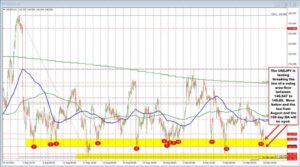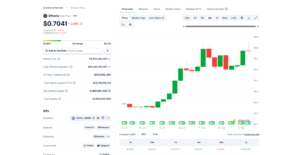Forex Economic Calendar Overview: Key Events for the Next Trading Week (15.09.2025–21.09.2025)

All key indicators for the Fed’s interest rate decision were published last week and earlier this month. It is now clear that the Fed will cut rates at its September meeting, scheduled from Tuesday to Wednesday, September 17, with the decision announced at 18:00 GMT. However, the extent of the cut and the possibility of further reductions remain uncertain.
In the upcoming week of September 15–21, 2025, market participants will focus on the release of crucial macroeconomic statistics from China, the UK, Canada, the US, New Zealand, and Australia, as well as the outcomes of the Canadian, UK, and Japanese central bank meetings.
Investors will pay close attention to the publication of the Fed’s meeting results on Wednesday and the following press conference.
Note: During the coming week, new events may be added to the calendar, and/or some scheduled events may be canceled. GMT time
The article covers the following subjects:
Major Takeaways
- Monday: the release of key macroeconomic data from China.
- Tuesday: UK labor market data, Canadian CPIs, US retail sales data.
- Wednesday: UK CPIs, Bank of Canada’s interest rate decision, Fed’s interest rate decision, New Zealand GDP.
- Thursday: Australian labor market data, Bank of England’s interest rate decision.
- Friday: Bank of Japan’s interest rate decision.
- Key event of the week: the Fed’s interest rate decision.
Monday, September 15
02:00 – CNY: Industrial Production. Retail Sales
The National Bureau of Statistics of China’s report on industrial production shows the output of Chinese industrial enterprises, such as factories and manufacturing facilities. The increase in industrial production is a positive factor for the yuan, indirectly signaling the possibility of accelerating inflation, which may force the People’s Bank of China to tighten monetary policy.
Conversely, the decline in the indicator value may negatively impact the yuan.
Previous values YoY: +5.7%, +6.8%, +5.8%, +5.9%, +6.2% in January 2025, +5.4%, +5.3%, +5.4%, +4.5%, +5.1%, +5.3%, +5.6%, +6.7%, +4.5%, +7.0%, +6.8%, +6.6%, +4.5%, +3.7%, +4.4%, +3.5%, +5.6%, +3.9%, +2.4% in February 2023.
The retail sales level index, published monthly by the National Bureau of Statistics of China, gauges the change in the aggregate value of sales at the retail level across the country. The index is often viewed as an indicator of consumer confidence and economic prosperity and reflects the state of the retail sector in the near term. An increase in the index value is usually positive for the yuan, while a decrease in the index value will affect it negatively. Previous values YoY: +3.7%, +4.8%, +6.4%, +4.0%, +3.7% in January 2025, +3.0%, +4.8%, +3.2%, +2.1%, +2.7%, +2.0%, +3.7%, +2.3%, +3.1%, +5.5%, +7.4%, +10.1%, +4.6%, +2.5%, +3.1%, +12.7%, +18.4%, +10.6%, +3.5%, -1.8%, -5.9% after +8% in the last months of 2019 and -20.5% in February 2020.
The data indicate that this sector of the Chinese economy continues to recover after a strong decline in February and March 2020. If the data prove weaker than the forecasted or previous values, the yuan may experience a decline, potentially a sharp one.
China is a major buyer of commodities and a supplier of a wide range of finished goods to the global commodity market. Since China’s economy is the second largest in the world, the release of its significant macroeconomic indicators can profoundly influence the overall financial market.
Besides, China is the largest trading partner of Australia and New Zealand, purchasing a significant amount of commodities from these countries.
Therefore, positive macro statistics from China may also exert a positive influence on these commodity currencies. Conversely, if the anticipated data indicates a deceleration in one of the world’s largest economies, it would be a detrimental factor for global stock markets and commodity currencies.
Tuesday, September 16
06:00 – GBP: Average Weekly Earnings Over the Last Three Months. Unemployment Rate
The UK Office for National Statistics publishes a report on average weekly earnings covering the period for the last three months, including and excluding bonuses.
This report is a key short-term indicator of employee average earnings changes in the UK. An increase in wages is positive for the British pound, whereas a low indicator value is unfavorable. Forecast: The September report suggests that average earnings, including bonuses, rose again in the last three months, including May, June, and July, after gaining +4.6%, +5.0%, +5.3%, +5.5%, +5.6%, +5.9%, +6.0%, +5.6%, +5.2%, +4.3%, +3.8%, +4.0%, 4.5%, +5.7%, +5.9%, +5.7%, +5.6%, +5.6%, +5.8%, +6.5%, +7.2%, +7.9%, +8.1%, +8.5%, +8.2%, +6.9%, +6.5%, +5.8%, +5.9%, +6.0%, +6.5%, +6.%, +6.1%, +5.5%, +5.2%, +6.4%, +6.8%, +7.0%, +5.6%, +5.7%, +4.8%, +4.3%, +4.2% in previous periods. The earnings value excluding bonuses also increased with percentages at +5.0%, +5.0%, +5.2%, +5.6%, +5.9%, +5.8%, +5.9%, +5.6%, +5.2%, +4.8%, +4.9%, +5.1%, +5.4%, +6.0%, +6.0%, +6.0%, +6.1%, +6.2%, +6.6%, +7.3%, +7.7%, +7.8%, +7.8%, +7.8%, +7.8%, +7.3%, +7.2%, +6.7%, +6.6%, +6.6%, +6.7%, +6.5%, +6.1%, +5.8%, +5.5%, +5.2%, +4.7%, +4.4%, +4.2%, +4.2%, +4.1%, +3.8%, +3.7%, +3.8% in previous periods. These figures show continued growth in employee earnings levels, which is positive for the British pound. If the data outperforms the forecast and/or previous values, the pound will likely strengthen in the currency exchange market. Conversely, if the data falls short of the forecast/previous values, the pound will be negatively affected.
The UK unemployment data will be released at the same time. Unemployment is expected to stand at 4.7% for the three months of May, June, and July (against 4.7%, 4.6%, 4.6%, 4.5%, 4.4%, 4.4%, 4.4%, 4.3%, 4.3%, 4.0%, 4.1%, 4.2%, 4.4%, 4.4%, 4.3%, 4.2%, 4.0%, 3.8%, 3.9%, 4.0%, 4.1%, 4.2%, 4.3%, 4.2%, 4.0%, 3.9% in previous periods).
Since 2012, the UK unemployment rate has fallen steadily from 8.0% in September 2012. The unemployment decline is a positive factor for the pound, while its growth negatively impacts the currency.
If the UK labor market data appears to be worse than the forecast and/or the previous value, the pound will be under pressure.
Regardless, when the UK labor market data is released, the pound and the London Stock Exchange are expected to experience increased volatility.
12:30 – CAD: Canadian Consumer Price Indexes
The Consumer Price Index (CPI) reflects the retail price trends of a selected basket of goods and services. Meanwhile, the Core CPI excludes fruits, vegetables, gasoline, fuel oil, natural gas, mortgage interest, intercity transportation, and tobacco products. The inflation target for the Bank of Canada ranges between 1% and 3%. A higher CPI reading is a sign of a rate hike and is positive for the Canadian dollar.
Previous values:
- CPI: +0.3% (+1.7% YoY), +0.1% (+1.9% YoY), +0.6% (+1.7% YoY), -0.1% (+1.7% YoY) in April, +0.3% (+2.3% YoY) in March, +1.1% (+2.6% YoY) in February, +0.1% (+1.9% YoY) in January 2025, -0.4% (+1.8% YoY) in December 2024, 0% (+1.9% YoY), +0.4% (+2.0% YoY), -0.4% (+1.6% YoY),-0.2% (+2.0% YoY), +0.4% (+2.5% YoY), -0.1% (+2.7% YoY), +0.6% (+2.9% YoY), +0.5% (+2.7% YoY), +0.6% (+2.9% YoY), +0.6% (+2.9% YoY), +0.3% (+2.8% YoY), 0% (+2.9% YoY), -0.3% (+3.4% YoY), +0.1% (+3.1% YoY), +0.1% (+3.1% YoY), -0.1% (+3.8% YoY), +0.4% (+4.0% YoY), +0.6% (+3.3% YoY), +0.1% (+2.8% YoY);
- Core CPI released by the Bank of Canada:+0.1% (+2.6% YoY), +0.1% (+2.7% YoY), +0.6% (+2.5% YoY), +0.5% (+2.5% YoY) in April, -0.2% (+2.2% YoY) in March, +0.7% (+2.7% YoY) in February, +0.4% (+2.1% YoY) in January 2025, +0.3% (+1.8% YoY) in December 2024, -0.1% (+1.6% YoY), +0.4% (+1.7% YoY), 0% (+1.6% YoY), -0.1% (+1.5% YoY), +0.3% (+1.7% YoY), -0.1% (+1.9% YoY), +0.6% (+1.8% YoY), +0.2% (+1.6% YoY), +0.5% (+2.0% YoY), +0.1% (+2.1% YoY), +0.1% (+2, 4% YoY), -0.5% (+2.6% YoY), +0.1% (+2.8% YoY), +0.3% (+2.7% YoY), -0.1% (+2.8% YoY), +0.1% (+3.3% YoY), +0.5% (+3.2% YoY), -0.1% (+3.2% YoY).
The data suggests that inflation continues to decelerate, which prompts the Canadian central bank to consider implementing a dovish monetary policy. If the expected data is worse than the previous values, it will negatively affect the Canadian dollar, but if the data exceeds expectations, it will bolster the currency.
12:30 – USD: US Retail Sales. Retail Sales Control Group
This Census Bureau report on retail sales reflects the total sales of US retailers of all sizes and types. The change in retail sales is a key indicator of consumer spending. The report is a leading indicator, and the data may be subject to significant revisions in the future. High indicator readings strengthen the US dollar, while low readings weaken it. A relative decline in the indicator may have a short-term negative impact on the US dollar, while a rise in the indicator will positively impact the currency.
In July 2025, the value of the indicator stood at +0.5% (after +0.6%, -0.9%, +0.1%, +1.5%, +0.2%, -0.9% in January, +0.4% in December, +0.7% in November, +0.4% in October and September, +0.1% in August, +1.1% in July, -0.2% in June, +0.2% in May, -0.2% in April, +0.5% in March, +0.7% in February, -1.1% in January 2024).
Retail sales are the main indicator of consumer spending in the United States, showing the change in the retail industry.
Retail sales serve as an indicator of domestic consumption, contributing the most to the US GDP and being one of the main factors influencing inflation. Deterioration of the indicator values is a negative factor for the US dollar. Inflation deceleration may prompt the Fed to begin the process of monetary policy easing.
The Retail Control Group indicator gauges volume in the retail industry and is used to calculate price indexes for most goods. High readings strengthen the US dollar, while low readings weaken the currency. A slight increase in the figures is unlikely to boost the dollar. If the data is lower than the previous readings, the dollar may be negatively impacted in the short term. Previous values: +0.5%, +0.5%, +0.4%, -0.2%, +0.4%, +1.0%, -0,8%, +0.7%, +0.4%, -0.1%, +0.7%, +0.3%, +0.4%, +0.9%, +0.4%, -0.3%, +0.9%, 0%, -0.4% in January 2024, +0.6%, +0.2%, +0.2%, +0.2%, +0.2%, +0.7%, +0.3%, +0.4%, +1.0%, -1.2%, -0.1%, +2.6% in January 2023.
Wednesday, September 17
06:00 – GBP: UK Consumer Price Index. Core Consumer Price Index
The Consumer Price Index (CPI) measures the retail prices of a group of goods and services comprising the UK consumer basket. The CPI is a key indicator of inflation. The British pound’s movement on the currency market and the London Stock Exchange FTSE 100 index performance depend on the release of the CPI data.
In July, the UK consumer inflation rose +0.1% (+3.8% YoY), after +0.3% (+3.6% YoY), +0.2% (+3.4% YoY) in May, +0.3% (+2.6% YoY) in March, +0.4% (+2.8% YoY) in February, +3.0% YoY in January 2025, +0.3% (+2.5% YoY) in December 2024, +0.1% (2.6% YoY), +0,6% (2.3% YoY) in October, 0% (+1.7%YoY) in September, +0.3% (+2.2% YoY) in August, -0.2% (+2.2% YoY) in July, +0.1% (+2.0% YoY) in June, +0.3% (+2.0% YoY) in May, +0.3% (+2, 3% YoY) in April, +0.6% (+3.2% YoY) in March, +0.6% (+3.4% YoY), -0.6% (+4.0% YoY) in January 2024, +0.4% (+4.0% YoY) in December.
The data suggests persistent inflationary pressures in the UK, which are expected to bolster the British pound, particularly if the actual data surpasses the forecasted values.
An indicator reading below the forecast/previous value may cause the weakening of the British pound since low inflation will force the Bank of England to stick to the easy monetary policy course.
The Core CPI, published by the Office for National Statistics, measures the price change in a selected basket of goods and services (excluding food and energy) over a given period. It is a key indicator for assessing inflation and changes in consumer preferences. A positive result strengthens the British pound, while a negative outcome weakens it.
In July, the core CPI gained +3.8% YoY, after +3.7% in June, +3.5% in May, +3.8% in April, +3.4% in March, +3.5% in February, +3.7% in January 2025, +3.2% in December 2024, +2.6% in November, +3.3% in October, +1.7% in September, +3.6% in August, +3.3% in July, +3.5% in June and May, +3.9%, +4.2%, +4.5%, +5.1% in January 2024, December and November, after rising +5.7% +6.1%, +6.2% three months earlier. The publication will likely positively impact the British pound in the short term if it exceeds the forecasted and previous values. A reading below the forecast and/or previous values may weaken the pound.
13:45 – CAD: Bank of Canada Interest Rate Decision and Accompanying Statement
At its 2022 and 2023 meetings, the Bank of Canada raised its interest rate and advocated for further increases. Since its September 2023 meeting, Canadian policymakers have held the interest rate at 5.00%, assuming that uncertainty caused by high geopolitical tensions around the world and slowing Chinese, American, and European economies will be accompanied by lower demand for oil. As oil is Canada’s primary export commodity, this situation may weaken its economic growth while grappling with high inflation.
However, at the June 5, 2024, meeting, the Bank of Canada reduced the interest rate by 0.25% to 4.75% for the first time since July 2023, making a total reduction of 1.75% (175 bp) in 2024. In March 2025, the rate was further slashed to the current 2.75%.
The central bank’s upcoming decision remains uncertain. The regulator may also take a pause at Wednesday’s meeting.
If the Bank of Canada’s accompanying statement regarding growing inflation and the prospects for further monetary policy signals further tightening, the Canadian dollar will strengthen. Conversely, if the regulator signals the need for a monetary policy easing, the Canadian currency will decline.
14:30 – CAD: Bank of Canada Press Conference
During the press conference, Bank of Canada Governor Tiff Macklem will provide an overview of the bank’s position and assess the current economic situation in the country. If the tone of his speech is hawkish regarding the Bank of Canada’s monetary policy, the Canadian dollar will strengthen. If Tiff Macklem is in favor of maintaining a soft monetary policy, the Canadian currency will decline.
Besides, Tiff Macklem may share his views on the ongoing trading tension between the US and Canada, including the exchange of tariff hikes that threaten to escalate into a full-scale trade war.
Anyway, the Canadian dollar is expected to be highly volatile during his speech.
18:00 – USD: US Fed Interest Rate Decision. Fed Commentary on Monetary Policy. FOMC Economic Projections
During the first half of 2024, the US Fed policymakers left monetary policy parameters unchanged at multiple meetings, maintaining the key interest rate at 5.50%. However, at the September, November, and December meetings, the US Fed’s leaders reduced the interest rate to the current 4.50% and did not rule out further reductions. Notably, a month before these decisions, US Fed Chairman Jerome Powell stated that the US central bank’s focus was shifting toward ensuring stability in the labor market. However, Powell emphasized that any decisions regarding interest rates would still hinge on the prevailing economic conditions.
Now, market participants expect the US central bank to continue its monetary easing cycle. Nevertheless, there is also a possibility of an interest rate hike if inflation starts to rise again, as Fed Chairman Jerome Powell repeatedly warned earlier.
It is widely anticipated that the rate will be cut by 0.25% at the upcoming meeting.
The financial market may experience higher volatility when the rate decision is announced, particularly in the US stock market and the US dollar, especially if the rate decision does not match the forecast or the Fed makes unexpected statements.
Powell’s commentaries may affect short-term and long-term trading in the US dollar. The Fed’s more aggressive approach to monetary policy is a positive factor that would strengthen the US dollar, while a more cautious position is negative for the greenback. Investors are eagerly awaiting Powell’s remarks on the Fed’s upcoming plans.
The Fed’s forecasts for interest rates, inflation, and economic growth over the next 1-2 years and beyond will draw significant attention. Equally important will be the individual FOMC members’ views on interest rates.
18:30 – USD: US Federal Reserve Open Market Committee Press Conference
The US Federal Reserve Open Market Committee (FOMC) press conference lasts approximately one hour. The resolution is read in the first part of the meeting, followed by a Q&A session, which may increase market volatility. Any unexpected statements by Jerome Powell on the Fed’s monetary policy will cause a hike in volatility in the US dollar and the US stock market.
22:45 – NZD: New Zealand GDP for Q2
The data release will heighten volatility in the New Zealand dollar. Given the recent rise in commodity and agricultural prices, particularly for dairy products, New Zealand’s major export, and considering that the coronavirus pandemic has had the least impact on New Zealand compared to other large economies, the New Zealand Q2 2025 GDP report will likely be positive.
Previous values YoY: -0.7%, -1.1%, -0.3%, -0.5%, +0.3%, -0.3%, -0.6%, +1.5%, +2.2%, +2.3%, +6.4%, +0.3%, +1.0%, +3.0% in Q4 2022.
The data so far remains contradictory, indicating a halt in the New Zealand economic recovery at the end of 2023 after a downturn in the first half of 2020. If the data is worse than the previous values, it will negatively affect the New Zealand dollar.
Thursday, September 18
01:30 – AUD: Employment Rate. Unemployment Rate
The employment rate reflects the monthly change in the number of employed Australian citizens. The increase in the indicator value positively impacts consumer spending, stimulating economic growth. A high reading is positive for the Australian dollar, while a low reading is negative. Previous indicator values: +24,500 in July, +2,000 in June, -2,500 in May, +89,000 in April, +32,200 in March, -52,800 in February, +44,000 in January 2025, +56,300 in December 2024, +35,600 in November, +15,900 in October, +64,100 in September, +42,600 in August, +48,900 in July, +52,300 in June, +39,500 in May, +37,400 in April, -6,100 in March, +120,400 in February, +11,900 in January 2024, -58,900 in December 2023, +55,500 in October, +13,400 in September, +62,300 in August, 0 in July, +19,800 in June, +83,800 in May, -14,700 in April, +93,800 in March, +45,100 in February, 23,100 in January 2023.
Besides, the Australian Bureau of Statistics will publish a report on the unemployment rate. It is an indicator that estimates the ratio of the share of the unemployed population to the total number of working-age citizens. The rise in the indicator readings demonstrates the weakening of the labor market, negatively impacting the national economy. A decrease in the indicator is positive for the Australian dollar.
Forecast: Australian unemployment has remained at its lowest levels and stood at 4.2% in August (against 4.2% in July, 4.3% in June, 4.1% in May, April, March, February, and January 2025, 4.0% in December 2024, 3.9% in November, 4.1% in October, September, and August, 4.2% in July, 4.1% in June, 4.0% in May, 3.8% in April, 3.7% in March and February, 4.1% in January, 3.9% in December and November, 3.8% in October, 3.6% in September, 3.7% in August and July, 3.5% in June, 3.6% in May, 3.7% in April, 3.5% in March and February, 3.7% in January, 3.5% in December, 3.4% in November and October, 3.5% in September and August, 3.4% in July, 3.5% in June, 3.9% in May and April, 4.0% in March and February, 4.2% in January), while the employment rate has increased.
The Reserve Bank of Australia has repeatedly stated that the Australian economy and the central bank’s plans are influenced by key indicators like the level of household debt and spending, wage growth, and the state of the labor market, in addition to the international trade situation. If the indicator readings are lower than expected, the Australian dollar may decline significantly in the short term, while higher data will strengthen the currency.
11:00 – GBP: Bank of England Interest Rate Decision. Bank of England Meeting Minutes. Monetary Policy Report
As a result of the August 2023 meeting, the interest rate was increased to 5.25%. The Bank of England’s Monetary Policy Committee has decided to raise borrowing costs amid a robust labor market to curb price growth. However, further tightening of monetary policy may be required to bring inflation to the 2.0% target.
Since the September 2023 meeting, the Bank of England has maintained a wait-and-see stance. Finally, on August 1, 2024, the central bank cut the interest rate by 0.25% to 5.00%, marking the first cut since August 2023. The current interest rate is 4.00%.
At the upcoming meeting, the Bank of England may decide to cut interest rates again, given the declining inflation in the country, or take a pause, considering the positive macro data from the UK and the complex geopolitical situation in Europe, particularly in Ukraine.
Analysts believe that the Bank of England may reduce the interest rate. However, the market reaction may be unpredictable.
At the same time, the BoE will publish the Monetary Policy Committee (MPC) minutes, including a breakdown of the votes for and against interest rate changes. The main UK risks after Brexit are related to expectations of a slowdown in the country’s economic growth, as well as a large deficit in the UK balance of payments account.
Uncertainty about the Bank of England’s next step persists. Meanwhile, the British Pound and FTSE100 futures offer a lot of trading opportunities during the publication of the Bank’s rate decision.
Besides, the Bank of England will release its monetary policy report, providing an assessment of the economic outlook and inflation. Volatility in the British pound may grow sharply during this period. Apart from GDP, the UK inflation rate is one of the primary indicators for the Bank of England’s monetary policy stance. A soft tone of the report will likely boost the British stock market but cause the British pound to weaken. Conversely, the report’s hawkish tone regarding inflation, implying an interest rate hike, will strengthen the pound.
Friday, September 19
After 03:00 (Exact Time Not Specified) – JPY: Bank of Japan Interest Rate Decision. Bank of Japan Press Conference and Commentary on Monetary Policy
The Bank of Japan will decide on the interest rate. At the moment, the benchmark rate in Japan is 0.50%. The rate will likely remain at the same level. If the rate is cut and returns to negative values, the yen may decline sharply in the currency market, and the Japanese stock market will likely increase. Anyway, a spike of volatility in the yen and Asian financial markets is expected during this period.
Since February 2016, the Bank of Japan has kept the deposit rate at -0.1% and the 10-year bond yield target around 0%.
During the March 19, 2024, meeting, the BoJ made the decision to increase the interest rate by 10 basis points, shifting it from -0.1% to 0% for the first time since 2007, thus concluding the period of negative interest rates that commenced in 2016. Concurrently, the target for long-term JGBs (YCC) was scrapped, although the BoJ intends to maintain the same level of JGB purchases per month without a specific target. On the other hand, the bank will cease the purchase of ETFs and REITs, gradually decrease, and eventually terminate the acquisition of commercial paper and corporate bonds within 12 months.
According to analysts, if the BoJ hints at further rate hikes, the yen will receive significant support.
During the press conference, BoJ governor Kazuo Ueda will comment on the monetary policy. Despite certain tightening measures, the BoJ continues to adhere to an extra-soft monetary policy. According to former Japanese central bank governor Haruhiko Kuroda, Japan should continue its current soft monetary policy. Markets usually respond prominently to speeches by the BoJ governor. The governor will likely mention the monetary policy again during his speech, leading to increased volatility not only in the yen but also in Asian and global financial markets.
06:00 – GBP: UK Retail Sales
The retail sales economic indicator is a key metric that tracks the level of consumer demand and significantly impacts market performance and the national currency. Additionally, it serves as an indirect indicator of inflation, making it a key concern for a country’s central bank and market participants.
The retail sales report is released by the UK Office for National Statistics. The Retail Sales change is considered to indicate the consumer spending level. High indicator values are positive for the British pound, while low readings are negative.
Previous index values YoY: +1.8%, -1.2%, +5.2%, +2.6%, +1.3%, +0.3% in January 2025, +2.2% (in December 2024), -0.7%, +0.9%, +2.3%, +1.2%, +0.5%, -1.9%, +0.6%, -2.8%, -0.7%, -0.8%, +0.1% (in January 2024).
06:30 – JPY: Bank of Japan Press Conference
During the press conference, Bank of Japan Governor Kazuo Ueda will comment on the bank’s monetary policy and interest rate decision. Markets usually react noticeably to speeches of the BoJ governor. If he touches on monetary policy during his speech, volatility will rise not only in the yen but also across Asian and global financial markets.
Price chart of USDX in real time mode
The content of this article reflects the author’s opinion and does not necessarily reflect the official position of LiteFinance broker. The material published on this page is provided for informational purposes only and should not be considered as the provision of investment advice for the purposes of Directive 2014/65/EU.
According to copyright law, this article is considered intellectual property, which includes a prohibition on copying and distributing it without consent.







